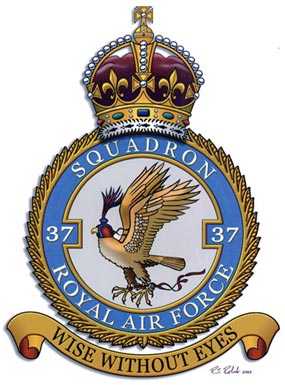OPERATIONS
The MASAF was unusual in that it was a combined force of USAAF and RAF units, however, each force operated independently. The primary difference between USAAF and RAF operations was that the USAAF operated by day while RAF bombers operated primarily by night. To better understand 37 Squadron operations, a brief overview of RAF Bomber Command is worthwhile.

Interior of the Operations Room at Bomber Command Headquarters.
RAF Bomber Command
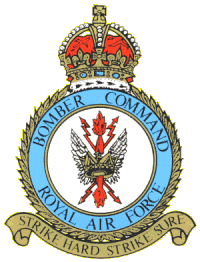
The Royal Air Force, formed on April 1st 1918 from the Royal Flying Corps and Royal Naval Air Service, was split into several main parts. RAF Bomber Command with HQ at High Wycombe was responsible for most light and medium, and all heavy, bomber units. At this time it was forbidden to attack anything other than military installations; factories were "private property".
During WWII, the Spitfires and Hurricanes of Fighter Command defended the United Kingdom against German aerial attacks - most notably during the Battle of Britain. Bomber Command’s role was to attack the enemy's own military strength - by bombing their airbases, shipping, troops, communications and all industries used in the German war effort.
Working on the maxim that "The bomber will always get through", early RAF tactics dictated that a formation of bombers could defend themselves in daylight against enemy fighter attack. This theory was quickly proved false as RAF bombers were lost in unsustainable numbers during daylight operations against German targets. Because of these heavy losses, the decision was made by the War Cabinet that Bomber Command would switch to night attacks. By mid-1940 these became the norm and the "private property" rule was shelved.
When flying at night with primitive navigational aids, early bombing was grossly ineffective. If unable to visually identify the target, crews bombed on dead reckoning. This was done by flying a known course for a known time from a known point, and dropping their bombs when they were supposed to be, in theory, over the target. Crews who dropped their bombs on this dead reckoning basis had been deemed to have successfully attacked the target.
The "Bomber Dream" of the 1930s, which promoted the theory of fleets of aircraft dropping precisely aimed loads against tactical and strategic targets such as military installations, communications facilities and war factories was soon proved to be just that - a Dream. It was impossible with the technologies available in the early 40s to even find the desired targets by night, let alone hit them. Bombs often failed to explode - a crew who were able to bomb accurately might have as many as 40% of its bombs fail to explode. The explosive of the day, Amatol, was not as powerful as German explosive, and the charge to weight ratio (i.e. the weight of actual explosive against the metal of the bomb itself) was far less than loads dropped by the Luftwaffe.
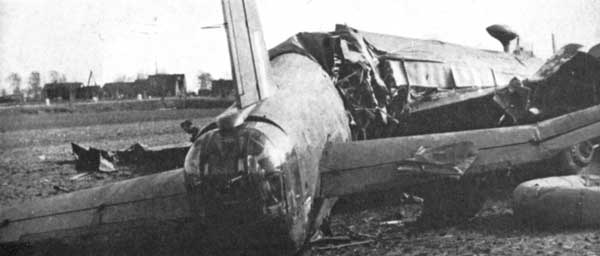
A Wellington shot down over North Germany in
1941.
The ineffectiveness of the early operations was carefully concealed from the general public, who were only too pleased to read in their newspapers that many hundreds of aircraft had attacked Berlin, Hamburg or the industrial centers around the Ruhr. Contemporary films such as "Target For Tonight" portrayed the popular image, but this was far from the truth, and losses were worsening as the German defenses improved their techniques.
The officially-commissioned Butt Report in 1941 revealed bombing to be shockingly inaccurate and recommended as the solution better navigational aids and better trained crew. Churchill recognized the importance of the report - "this is a very serious paper and seems to require urgent attention". The report was hugely revealing with long term serious implications for Bomber Command.
Gradually the standard of equipment and training improved. From early 1941 onwards the obsolete types of "medium" twin-engined bombers gave way to the "heavy" four-engined types, electronic aids arrived, and aircrew received comprehensive training in Canada, America, or South Africa.
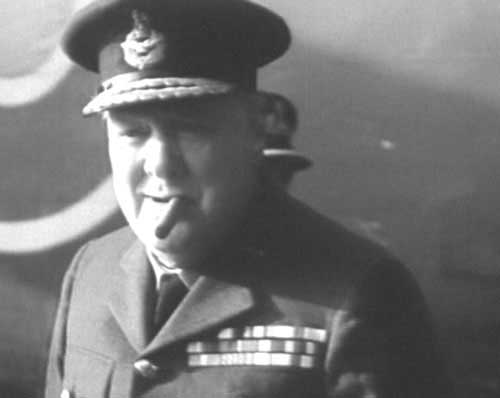
Prime Minister Winston Churchill in RAF uniform.
For almost the entire war, Winston Churchill was a strong advocate of aerial bombing, realizing the importance of forcing the Germans to defend their own homeland. In September 1940, at the height of the Battle of Britain, he declared:
"The fighters are our salvation but the bombers alone provide the means of victory. We must therefore develop the power to carry an ever-increasing volume of explosives to Germany, so as to pulverize their entire industry and scientific structure on which the war effort and economic life of the enemy depends, whilst holding him at arm’s length from our island."
The vital task of bombing Germany fell to RAF aircrews with an average age of just 22 - they faced some of the most terrifying combat conditions of WWII. Bomber Command was the only arm of the British forces to continually attack the German homeland throughout the war. The price was high. For every 100 bomber aircrew:
51 were killed on operations
9 were killed on active service
3 were seriously injured
12 were taken prisoner of war
1 was shot down and evaded capture
24 survived
Over 55,000 RAF bomber aircrew lost their lives during WWII.
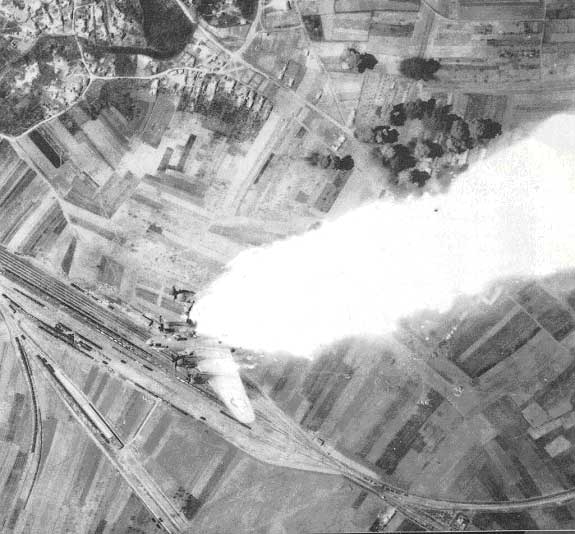
A B-17 Flying Fortress goes down in flames over a target after being hit by flak.

